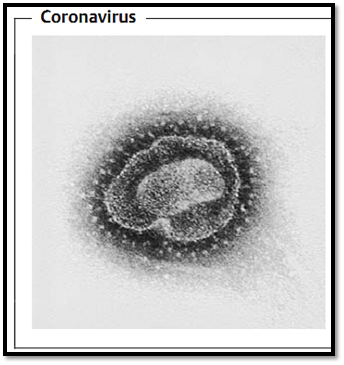


 النبات
النبات
 الحيوان
الحيوان
 الأحياء المجهرية
الأحياء المجهرية
 علم الأمراض
علم الأمراض
 التقانة الإحيائية
التقانة الإحيائية
 التقنية الحيوية المكروبية
التقنية الحيوية المكروبية
 التقنية الحياتية النانوية
التقنية الحياتية النانوية
 علم الأجنة
علم الأجنة
 الأحياء الجزيئي
الأحياء الجزيئي
 علم وظائف الأعضاء
علم وظائف الأعضاء
 الغدد
الغدد
 المضادات الحيوية
المضادات الحيوية|
Read More
Date: 20-11-2015
Date: 2025-01-02
Date: 18-11-2015
|
Coronaviruses
Infections with coronaviruses are widespread in humans and animals. Human pathogens include causative agents of rhinitislike infections and the virus of the “severe acute respiratory syndrome” (SARS), which first erupted in China in 2002.
Diagnosis: serology or electron microscopy for common cold strains; PCR or isolation for SARS.
Pathogen. The Coronaviridae family includes several viral species that can infect vertebrates such as dogs, cats, cattle, pigs, rodents, and poultry. The name (corona, as in wreath or crown) refers to the appearance of the viruses (Fig. 1). One coronavirus species (human coronavirus, HuCV) is known since some time to be a human pathogen. It has at least two serotypes and probably a number of serological variants. In November 2002, a new coronavirus emerged in China and, after originally being mistaken as a new influenza recombinant, was identified as the causative agent of severe acute respiratory syndrome, or SARS, in spring 2003. Its origin, possibly from animals, is not known to date.

Fig. 2 “Spikes” with club or drumstick-like swellings are located at regular, relatively generous intervals on the pleomorphic envelope, which measures 80-220 nm in diameter.
Pathogenesis and clinical picture. Common cold-coronaviruses cause an everyday variety of respiratory infections, which are restricted to the ciliated epithelia of the nose and trachea. They are responsible for about 30% of common cold infections.
The immunity conferred by infection, apparently IgA-dependent, is shortlived. Reinfections are therefore frequent, whereby the antigenic variability of the virus may be a contributing factor. Various enteral coronaviruses with morphologies similar to the respiratory types have also been described in humans. Their pathogenicity, and hence their contribution to diarrhea, has not been clarified.
The SARS virus is transmitted aerogenically with an incubation time of two to 10 days. Clinically, fever and a marked shortness of breath is noted, developing into a severe atypical pneumonia with new pulmonary infiltrates on chest radiography. Shedding of virus is by respiratory discharges. Whether 8 the virus present in other body fluids and excreta plays a decisive role for virus transmission is not yet clear.
Diagnosis. The common-cold coronavirus can be grown in organ cultures of human tracheal tissue or in human diploid cells. Isolating the viruses for diagnostic purposes is not routine. Serodiagnosis (complement-binding reaction, immunofluorescence or enzyme immunoassay) and electron microscopy are feasible methods.
The SARS virus can be identified by PCR or isolated in the Vero cell line.
Epidemiology and prevention. In November 2002, an outbreak of atypical pneumonia, later termed SARS, occurred in the southern Chinese city of Guangzhou (Guangdong Province). Only in February of 2003, the world was alerted about the lung disease, shortly before it escaped China, when a Guangdong resident in a Hong Kong hotel transmitted it to other guests who spread it to Toronto, Hanoi, Singapore, and elsewhere. Transmission of the virus is by droplets, but close contact (“household transmission”) with possibly other routes of transmission seems important. The only preventive measure to date is exposure prevention. Under therapy with ribavirin and intensive care, mortality of SARS is around 10%.



|
|
|
|
التوتر والسرطان.. علماء يحذرون من "صلة خطيرة"
|
|
|
|
|
|
|
مرآة السيارة: مدى دقة عكسها للصورة الصحيحة
|
|
|
|
|
|
|
نحو شراكة وطنية متكاملة.. الأمين العام للعتبة الحسينية يبحث مع وكيل وزارة الخارجية آفاق التعاون المؤسسي
|
|
|